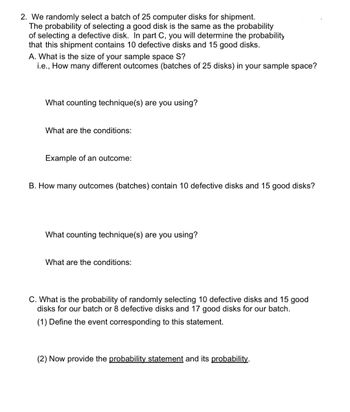
A First Course in Probability (10th Edition)
10th Edition
ISBN: 9780134753119
Author: Sheldon Ross
Publisher: PEARSON
expand_more
expand_more
format_list_bulleted
Question
2.

Transcribed Image Text:2. We randomly select a batch of 25 computer disks for shipment.
The probability of selecting a good disk is the same as the probability
of selecting a defective disk. In part C, you will determine the probability
that this shipment contains 10 defective disks and 15 good disks.
A. What is the size of your sample space S?
i.e., How many different outcomes (batches of 25 disks) in your sample space?
What counting technique(s) are you using?
What are the conditions:
Example of an outcome:
B. How many outcomes (batches) contain 10 defective disks and 15 good disks?
What counting technique(s) are you using?
What are the conditions:
C. What is the probability of randomly selecting 10 defective disks and 15 good
disks for our batch or 8 defective disks and 17 good disks for our batch.
(1) Define the event corresponding to this statement.
(2) Now provide the probability statement and its probability.
Expert Solution
This question has been solved!
Explore an expertly crafted, step-by-step solution for a thorough understanding of key concepts.
Step by stepSolved in 4 steps

Knowledge Booster
Similar questions
Recommended textbooks for you
 A First Course in Probability (10th Edition)ProbabilityISBN:9780134753119Author:Sheldon RossPublisher:PEARSON
A First Course in Probability (10th Edition)ProbabilityISBN:9780134753119Author:Sheldon RossPublisher:PEARSON

A First Course in Probability (10th Edition)
Probability
ISBN:9780134753119
Author:Sheldon Ross
Publisher:PEARSON
